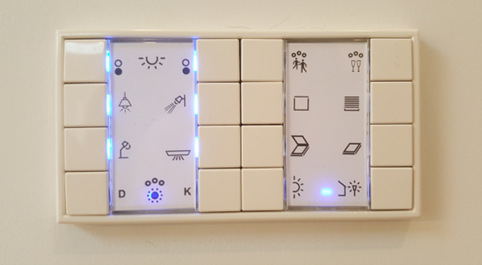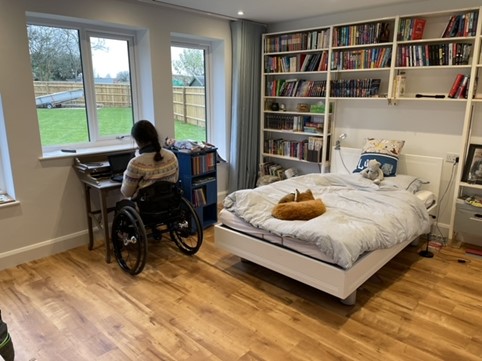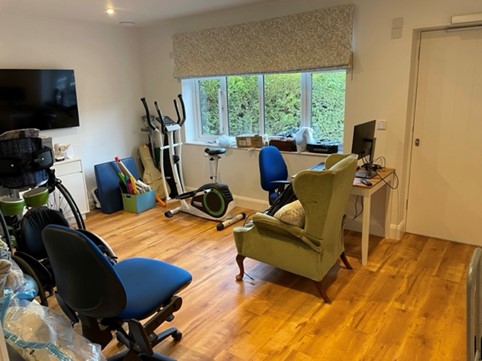KNX UK member, Household Automation was approached by a consultant following a referral from an occupational therapist regarding the rehabilitation of a car accident victim.
Lucie is wheelchair dependent and her family was purchasing a new property for adaptation to allow her to live at home with as much independence as possible. The brief was to provide an enhanced standard of living in a family home that didn’t feel like a medical environment.
Single Dwelling Benefits
The advantages of KNX technology for leading innovative assistive projects has been long established in the smart home industry. Its flexibility means changes to the system can be implemented easily and economically as the needs of occupants develop, helping to improve the long term value of commercial installations such as self-contained accommodation and nursing homes.
However, the value of KNX in single dwelling installations is often overlooked by developers and home owners with the longevity and flexibility of the system giving a long term return on the investment.
With the retrofit installation of the KNX backbone, Household Automation could ensure that the entire family’s needs would be met now and in the future.
The scope of the control system included internal and external lighting, under floor heating, door and window openers throughout, blind control and an entry system.
Working alongside the consultant and occupational therapist, Household Automation were able to gain an understanding of the functional requirements of Lucie’s environment. The system was specified and designed to offer optimum comfort and independence.

Dual Control
A key consideration was to prevent Lucie having to transfer into her wheelchair to control her environment.
The dual control of functions use sleek Jung wall switches and a smartphone app by BAB Tech to provide a robust solution that prevents any point of failure. All the network devices operate two way interaction with the KNX system, however functions such as lighting, blinds and window openers have manual wall switches located in the room where the device is, in case of network failure.
In Lucie’s bedroom the light, ventilation, temperature and door positions have dual controls via the wall switches or smartphone app. This gives her complete control over the bedroom environment while she relaxes in bed. The addition of integrated ceiling speakers, also controlled using the app help to make this a calm and enjoyable space of her own
The therapy room was designed in consultation with professionals to provide physical and occupational therapy to support Lucie’s long-term rehabilitation. The equipment used during treatment can cause isolated heating of the room, so efficient ventilation is essential.
The wall switches provide quick access to window and door operation for responsive ventilation. They can also be operated via the app, along with the underfloor heating and lighting.

In Lucie’s bedroom the light, ventilation, temperature and door positions have dual controls via the wall switches or smartphone app. This gives her complete control over the bedroom environment while she relaxes in bed. The addition of integrated ceiling speakers, also controlled using the app help to make this a calm and enjoyable space of her own.
The therapy room was designed in consultation with professionals to provide physical and occupational therapy to support Lucie’s long-term rehabilitation. The equipment used during treatment can cause isolated heating of the room, so efficient ventilation is essential.

The wall switches provide quick access to window and door operation for responsive ventilation. They can also be operated via the app, along with the underfloor heating and lighting.
A home for the whole family
The aesthetic design of the system was considerate of the requirement for a non-medical environment with a family home feeling. Walls are clean and clutter free, with no visible wires or equipment cables, and no bolted on equipment. The Jung switches selected in consultation with the client are sleek, underwhelming and extremely functional. These design considerations mean that at first glance the home doesn’t appear to be assistive.
The ability to retain design aesthetics while controlling complex building technology is one of KNX’s major advantages in the future proofing of residential dwellings.

In the living room mood settings can be triggered using simple commands via the wall switches or smartphone app. This means moods and environments can be achieved using any combination of lamps and feature lighting, without having to reach for switches that are awkwardly out of reach.
The lighting scenes are all accessible and can be set up in the app – once again they are all stored in the switches so if there is a network glitch then the wall switch will always operate the last scene set.
The blinds and curtains are also dual controlled so that the chaise lounge can be enjoyed for reading, any time of the day by any family member.
“We are delighted with the new home, which is an opportunity to live as a family in cosy comfort and have Lucie on a more equal user footing. It means she is asking for help less often and doesn’t feel as much of a burden when adjusting light settings or her own environment. She can control things better and doesn’t crash into things when trying to open curtains. We can also see the future much more easily, as we can visualize her as an adult user in a similar home environment. The fact the products used achieve a stylish finish is fantastic, as Lucie has never sought out pity for her injury, and disability products could trigger this if they stood out for being unaesthetic. Overall, we feel this is our home and are grateful for all KNX enables” Lucie’s Mum.
For guidance regarding the possibilities of KNX in assisted living projects KNX UK can provide resources and training to up-skill integrators and specifiers. For advice on any KNX residential project Household Automation can offer advice, design and quotations.


